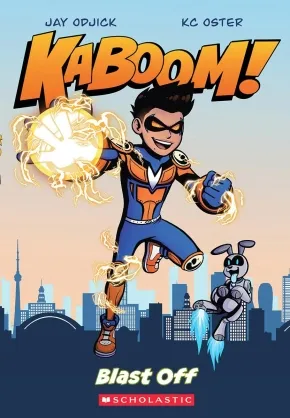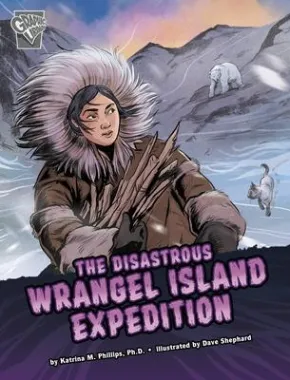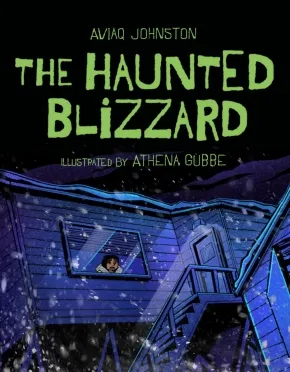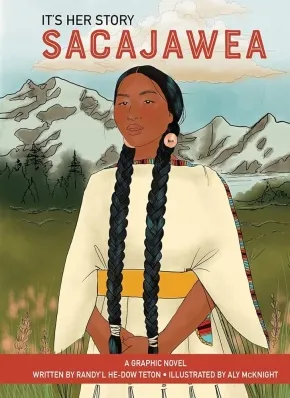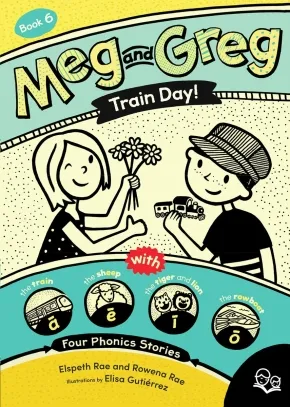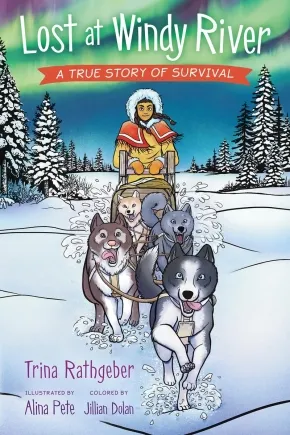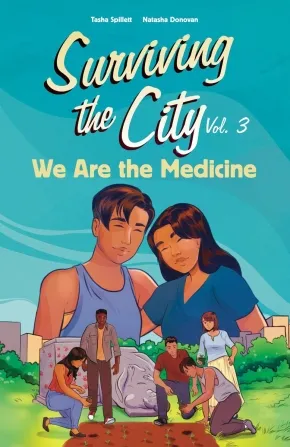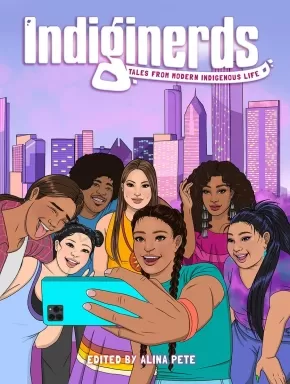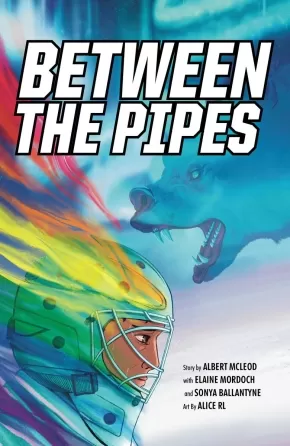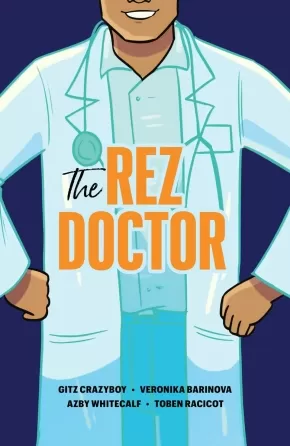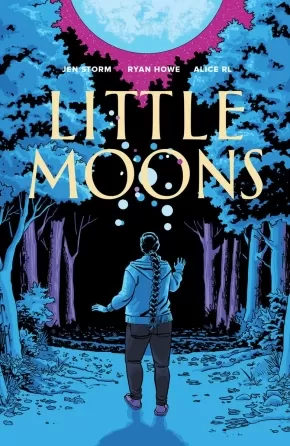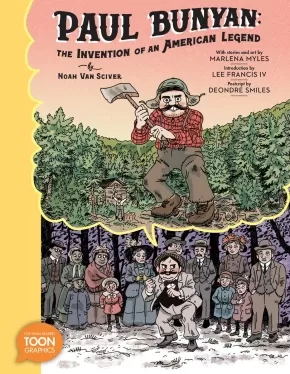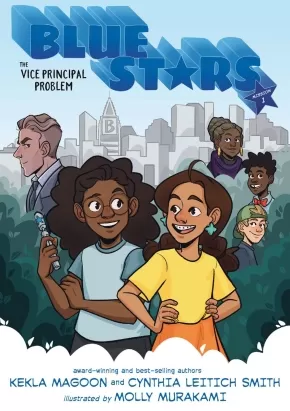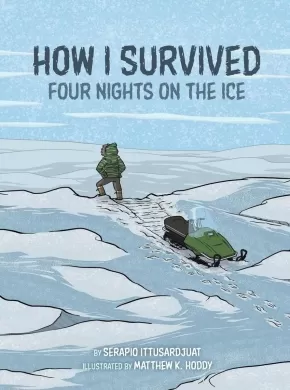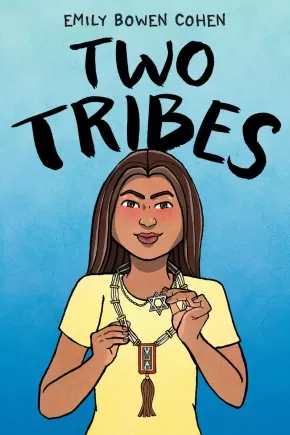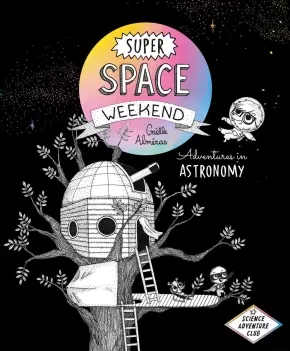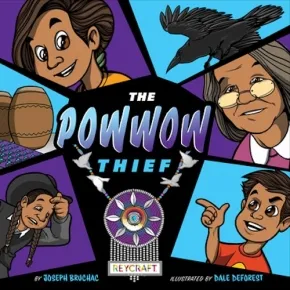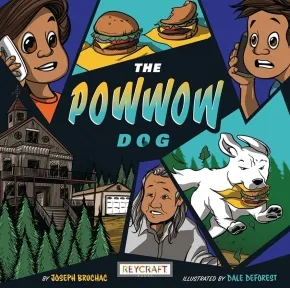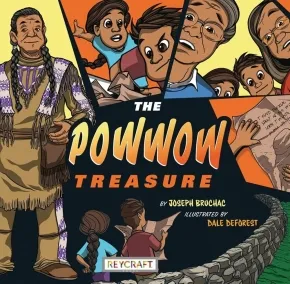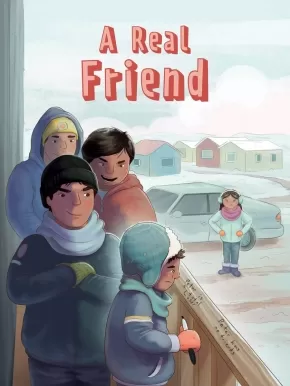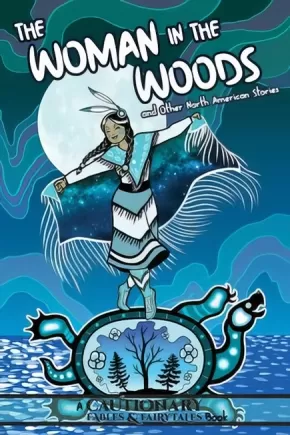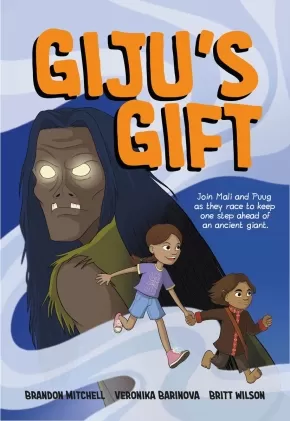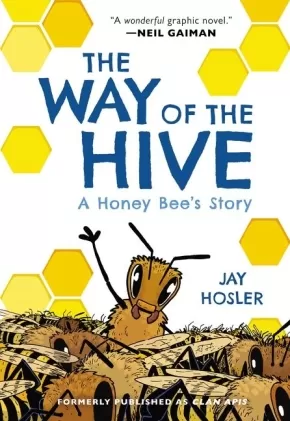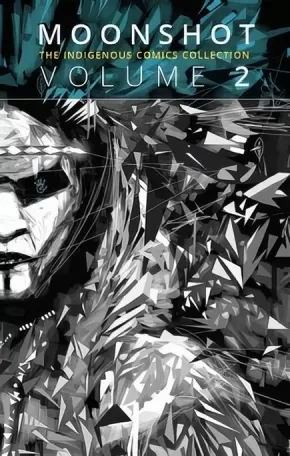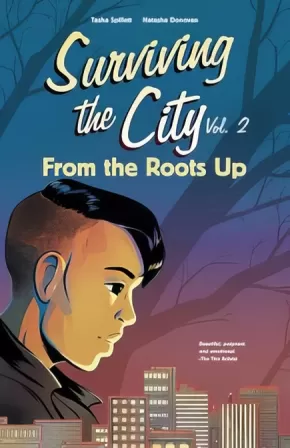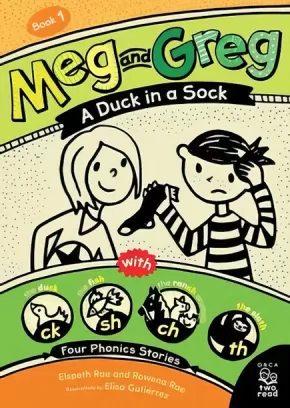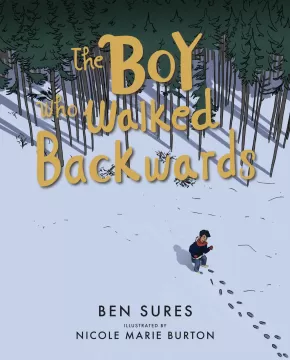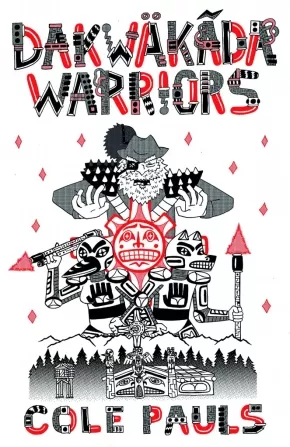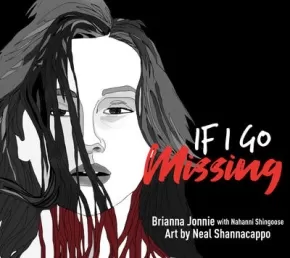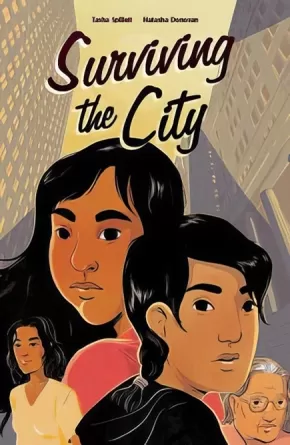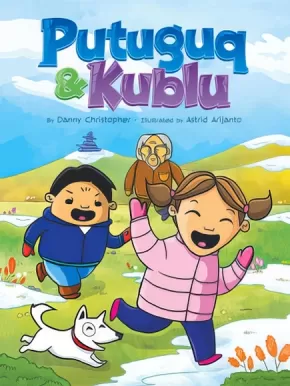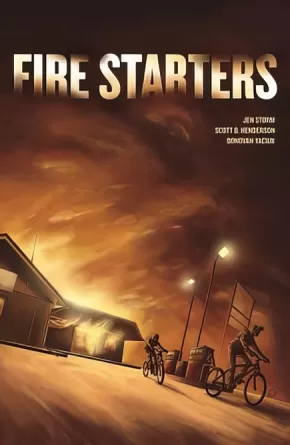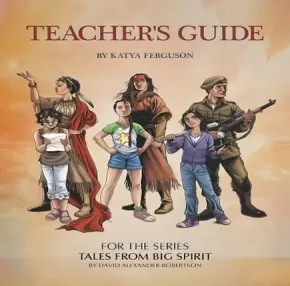
Graphic Novels
1
-
15
of
68 Results;
Sort By
Go To
of 5
Kaboom! Volume 1: Blast Off
$18.99
Artists:
Format:
Paperback
Text Content Territories:
Indigenous Canadian;
ISBN / Barcode: 9781443198363
Synopsis:
Synopsis:
Meet Kaboom: Zack Commonda, agent of F.U.S.I.O.N (First Universal Secret Indigenous Operatives Network), and the newest superkid on the block! Well . . . sort of. He’s still figuring it all out.
When we meet Zack, he’s being looked after by his super-cool Auntie Jess and dreaming of one day being like his hero, slick business tycoon Konstantin Pierce. Zack’s parents are away — yet again — for their important careers in “refrigerator sales.” Little does Zack know their true identities: Greywolf and Shadowbird are F.U.S.I.O.N agents on a mission to protect Indigenous artifacts from a nefarious tomb-robber!In this series launch, acclaimed creator and lifelong comics fan Jay Odjick introduces a superhero for our times.
Educator Information
Recommended for ages 8 to 12.
Additional Information
142 pages | 6.00" x 8.75" | Paperback
The Disastrous Wrangel Island Expedition
$11.99
Artists:
Format:
Paperback
Text Content Territories:
Indigenous American; Alaska Native; Inupiat (Alaskan Inuit);
ISBN / Barcode: 9781666322361
Synopsis:
Synopsis:
In 1921, Inupait seamstress Ada Blackjack joined a a group of four white men who wanted to establish a trading post on Wrangel Island in the freezing Arctic Ocean. The explorers were stranded on the island when their return ship was forced to turn back due to ice. Facing harsh conditions and dwindling food supplies, the men died one by one, but Ada remained. Find out how she alone managed to survive the disastrous expedition.
Reviews
"The lesser-known 1921 Wrangel Island Expedition is chronicled in this graphic novel.... The book begins by introducing its two key players: Ada Blackjack (a young Inuit single mother from Nome, Alaska) and Vilhjalmur Steffansson (an aging white explorer of Icelandic heritage). Steffansson was determined to establish a European colony on Wrangel Island, off the coast of Siberia. He assembled a five-man team of explorers, and Blackjack, desperate for money, joined them. While the writing is a bit stilted, the artwork makes the tale quite lively, especially once the expedition reaches the uninhabited island. Readers will become engrossed in the team’s efforts to survive and be impressed with how Blackjack proves herself the most capable person there; indeed, she’s the sole survivor. A map and additional information conclude."— Julia Smith, Booklist
Educator Information
Recommended for ages 8 to 11.
Additional Information
32 pages | 7.00" x 9.00" | Paperback
The Haunted Blizzard
$22.95
Artists:
Format:
Hardcover
Text Content Territories:
Indigenous Canadian; Inuit;
ISBN / Barcode: 9781772275605
Synopsis:
Synopsis:
A teenage girl walks home in a burgeoning blizzard, happy to have an unexpected snow day. Ignoring an Elder’s warning about the terror the blizzard holds, she finds herself alone in her home with an unseen presence stalking and tormenting her. What does it want? And will she survive?
Educator Information
Recommended for ages 12 to 18.
Additional Information
40 pages | 7.00" x 9.00" | Hardcover
It's Her Story Sacajawea: A Graphic Novel (7 in Stock)
$37.50
Artists:
ISBN / Barcode: 9798765402962
Synopsis:
Synopsis:
A graphic novel for children ages 7 to 10. Sacajawea was a brilliant, multilingual Shoshone girl who was torn from her home at a young age. In 1804, she set out with the Lewis and Clark Expedition, acting as an interpreter and guide across hundreds of miles of unmapped land to reach the Pacific Ocean. Almost 200 years later, she became the first Indigenous woman to appear on a US coin. This is her story.
Educator Information
Recommended for ages 7 to 10.
Additional Information
42 Pages | 6.5o" x 8.10 | Library Binding
Meg and Greg: Train Day!
$16.95
Artists:
Format:
Paperback
ISBN / Barcode: 9781459838260
Synopsis:
Synopsis:
A decodable book featuring four phonics stories for striving readers, with special features to help children with dyslexia or other language-based learning difficulties find reading success.
Join Meg, Greg and friends on vacation where they throw a birthday party on a train, rescue a sheep from a creek, volunteer for a wild night in the circus and compete in a rowboat race. Plus, take a peek at a few of Greg's vacation photos in a bonus mini story!
Reviews
“The ‘Meg and Greg’ series continue to deliver valuable phonics instruction through engaging stories. The series offers a rare and much-needed resource for children with dyslexia. The adult-child team reading approach is innovative and makes this series a valuable addition to any collection, particularly for libraries supporting diverse reading needs." - School Library Journal (SLJ) Series Made Simple
“While Meg and Greg: Train Day! is designed as a decodable book, the humour, the problem solving, and the variety of characters, together with entertaining graphics and the chapter book format, will appeal to all children in grades 2 to 4. Once the format is explained to the child and proficient reading partner, both readers will enjoy a fun, engaging reading journey together. Highly recommended.”- CM: Canadian Review of Materials
Educator & Series Information
Recommended for ages 6 to 9.
Meg and Greg: Train Day! is the sixth book in the Meg and Greg series designed for shared reading between a child learning to read and an experienced reader. The four stories inside (plus a bonus mini story!) introduce long vowels using vowel teams (long a: ai, ay, a, a-e; long e: ee, ea, e, y, e-e; long i: igh, ild, ind, i, y, i-e; long o: oa, ow, old, oll, olt, ost, o, o-e; long u: ue, ew, u, u-e). In addition to the familiar comic-style kids’ pages, highly controlled and decodable prose pages gently increase the amount of text that readers experience and provide even more opportunities to practice the reading skills previously introduced in Meg and Greg Books 1–5.
Fountas & Pinnell Text Level Gradient: L
Lexile measure: 460L
Guided Reading Level: L
Additional Information
160 pages | 5.87" x 8.25" | Paperback
Lost at Windy River: A True Story of Survival
$19.95
Format:
Paperback
Text Content Territories:
Indigenous Canadian; First Nations; Cree (Nehiyawak); Woodland Cree; Rocky Cree; Peter Ballantyne Cree Nation;
ISBN / Barcode: 9781459832268
Synopsis:
Synopsis:
Iskwew Pithasew nitisithikason. My name is Lady of the Thunderbird, and this is my story.
It takes courage and bravery to survive in the barrens.
In 1944, thirteen-year-old Ilse Schweder got lost in a snowstorm while checking her family's trapline in northern Canada. This is the harrowing story of how a young Indigenous girl defies the odds and endures nine days alone in the unforgiving barrens. Ilse faces many challenges, including freezing temperatures, wild animals, snow blindness and frostbite. With no food or supplies, she relies on Traditional Indigenous Knowledge passed down from her family. Ilse uses her connection to the land and animals, wilderness skills and resilience to find her way home.
This powerful tale of survival is written by Ilse Schweder's granddaughter.
Reviews
“Colorful illustrations in classic comic-book style help readers explore the challenging landscape. An excellent choice for a book report and good addition to a children’s nonfiction collection.”- School Library Journal (SLJ), starred review
Educator Information
Recommended for ages 9 to 12.
Fountas & Pinnell Text Level Gradient: T
Lexile measure: GN700L
Guided Reading Level: T
Additional Information
96 pages | 6.00" x 9.00" | Paperback
We Are the Medicine: Surviving the City Vol. 3
$21.95
Artists:
Format:
Paperback
Text Content Territories:
Indigenous Canadian; First Nations; Cree (Nehiyawak); Anishinaabeg;
ISBN / Barcode: 9781774921104
Synopsis:
Synopsis:
Miikwan and Dez are in their final year of high school. Poised at the edge of the rest of their lives, they have a lot to decide on. Miikwan and her boyfriend, Riel, are preparing for university, but Dez isn’t sure if that’s what they want for their future.
Grief and anger take precedence over their plans after the remains of 215 children are found at a former residential school in British Columbia. The teens struggle with feelings of helplessness in the face of injustice. Can they find the strength to channel their frustration into action towards a more hopeful future?
We Are the Medicine is the moving final volume of the best-selling Surviving the City series.
Reviews
"Tasha's graphic novel gives us an unflinching view of youth sovereignty and the reclamation of Indigenous philosophy and sacred spaces in Winnipeg's core. Guided by an Elder, the friends at the centre of the story confront uncomfortable truths that have sustained our colonial past, riding on the edge of emotions and activism to uphold the integrity of their ancestors. A must-read for all youth who want to build an equitable, just society." — Elder Albert McLeod, author of Between the Pipes
“A fantastic read for teens to learn about Indigenous issues through a clear and accurate representation.” — Youth Services Book Review
Educator & Series Information
Recommended for ages 12 to 18.
This is the third volume in the Surviving the City graphic novel series, which is also part of the Debwe Series.
Surviving the City is a contemporary graphic novel series about young Indigenous women navigating their way in an urban environment. It includes:
Surviving the City
From the Roots Up
We Are the Medicine
A Teacher Guide is available: Surviving the City Teacher Guide: Exploring Identity, Allyship, and Social Action for Meaningful Change in Grades 7-12
Recommended in the Indigenous Books for Schools catalogue as a valuable resource for English Language Arts and Social Studies in grades 8 to 12.
Caution: This work's topics include residential schools, death, violence, police brutality, and racism.
Themes: Coming of Age, Community, Connection to Culture, Healing, Residential Schools.
Additional Information
64 pages | 6.50" x 10.00" | Paperback
Four Faces of the Moon (HC) (4 in Stock)
$24.95
Artists:
Format:
Hardcover
Text Content Territories:
Indigenous Canadian; First Nations; Anishinaabeg; Cree (Nehiyawak); Stoney-Nakoda (Nakota); Métis;
ISBN / Barcode: 9781773214542
Synopsis:
Synopsis:
On a journey to uncover her family’s story, Spotted Fawn travels through time and space to reclaim connection to ancestors, language, and the land in this essential graphic novel.
In the dreamworld, she bears witness to a mountain of buffalo skulls, a ghostly monument to the slaughter of the buffalo—a key tactic to starve and contain the Indigenous People onto reservations.
Spotted Fawn must travel through her own family history to confront the harsh realities of the past and reignite her connection to her people and the land. Her darkroom becomes a portal, allowing her glimpses into the lives of her relatives. Guided by her ancestors, Spotted Fawn’s travels through the past allow her to come into full face—like the moon itself.
Adapted from the acclaimed stop-motion animated film of the same name, also by Strong, Four Faces of the Moon brings the history of the Michif, Cree, Nakoda, and Anishinaabe Peoples alive on the page.
Backmatter by Dr. Sherry Farrell Racette (Michif), an associate professor of Native Studies and Women’s and Gender Studies at the University of Manitoba, provides information on Michif culture and history.
Awards
- 2023 Snow Willow Award, Saskatchewan, Young Readers' Choice Award
- 2022 Great Graphic Novels for Teens, YALSA
Reviews
“Worthwhile . . . and offers interesting perspectives on the search for Indigenous identity.” — CM Reviews, 03/05/21
“This is magnificent storytelling. This is Spotted Fawn magic.” —Richard Van Camp, author of Little You, and We Sang You Home
“Moving and intense . . . the graphic novel effectively portrays how Indigenous youth can reconnect to their ancestors through art, language, and cultural knowledge.” — School Library Journal, 04/30/21
Educator Information
Recommended for ages 12+
Unique visuals: This is a groundbreaking project with stunning spreads adapted from award-winning stop-motion animation film of same name. Art is all manipulated and modified stills from the film, that itself uses elaborate sets and puppetry.
This is an #ownvoices story. Amanda Strong is a member of the Michif Nation.
The book includes a note from the author. Strong did a lot of research about family and their involvement in historical events like the Red River Rebellion, discovering connections to personal and political history later in life. Additional resources at the end of the book by Dr. Sherry Farrell-Racette (Michif), an associate professor of Native Studies and Women’s and Gender Studies at the University of Manitoba, provides information on Michif culture and history and the injustices of colonialism. Includes information on:
1. Moon – cycles, symbols, cultural ties
2. What is a Michif? What is a Métis
3. Historical events
4. Timeline
Additional Information
208 pages | 7.10" x 10.10" | Hardcover
The Ribbon Skirt: A Graphic Novel
$16.99
Artists:
Format:
Paperback
Text Content Territories:
Indigenous;
ISBN / Barcode: 9781338843255
Synopsis:
Synopsis:
A joyful coming-of-age middle-grade graphic novel by debut Indigenous creator Cameron Mukwa about the journey of a two-spirit kid who wants to create a ribbon skirt for the upcoming powwow.
Ten-year-old Anang wants to make a ribbon skirt, a piece of clothing typically worn by women in the Anishinaabe tradition, for an upcoming powwow. Anang is two-spirit and nonbinary and doesn't know what others will think of them wearing a ribbon skirt, but they're determined to follow their heart's desire. Anang sets off to gather the materials needed to make the skirt and turns to those around them -- their family, their human and turtle friends, the crows, and even the lake itself -- for help. And maybe they'll even find a new confidence within themself along the way.
Educator Information
Recommended for ages 8 to 12.
Additional Information
192 pages | 6.00" x 9.00"
Indiginerds: Tales from Modern Indigenous Life
$30.95
Artists:
Format:
Paperback
Text Content Territories:
Indigenous Canadian;
ISBN / Barcode: 9781638991335
Synopsis:
Synopsis:
First Nations culture is living, vibrant, and evolving, and generations of Indigenous kids have grown up with pop culture creeping inexorably into our lives. From gaming to social media, pirate radio to garage bands, Star Trek to D&D, and missed connections at the pow wow, Indigenous culture is so much more than how it’s usually portrayed. Indiginerds is here to celebrate those stories!
Featuring an all-Indigenous creative team, Indiginerds is an exhilarating anthology collecting 11 stories about Indigenous people balancing traditional ways of knowing with modern pop culture. Includes work by Alina Pete, PJ Underwood, Kameron White, Rhael McGregory, and many more.
Educator Information
Recommended for ages 12 to 18.
Full Creator Listing: Tate Allen, Ida Aronson, Jordanna George, Raven John, Nipinet Landsem, Rhael McGregor, Sam “Mushki” Medlock, Alina Pete, Wren Rios, PJ Underwood, Kameron White
Additional Information
120 pages | 6.62" x 10.25" | Paperback
Between the Pipes
$21.95
Artists:
Format:
Paperback
Text Content Territories:
Indigenous Canadian; First Nations; Cree (Nehiyawak);
ISBN / Barcode: 9781774921043
Synopsis:
Synopsis:
In this engrossing graphic novel, teen hockey player Chase learns more about himself and his identity in the face of prejudice and homophobia.
Thirteen-year-old Chase’s life and identity should be simple. He’s the goalie for his hockey team, the Eagles. He’s a friend to Kevin and Jade. He's Kookum's youngest grandchild. He’s a boy. He should like girls.
But it’s not that simple. Chase doesn’t like girls the way that the other boys do. It’s scary being so different from his peers. Scarier still is the feeling that his teammates can tell who he is—and that they hate him for it. If he pretends hard enough, maybe he can hide the truth.
Real strength and change can’t come from a place of shame. Chase’s dreams are troubled by visions of a bear spirit, and the more he tries to hide, the more everything falls apart. With the help of an Elder, and a Two-Spirit mentor, can Chase find the strength to be proud of who he is?
Between the Pipes explores toxic masculinity in hockey through the experiences of an Indigenous teen.
Reviews
“Highlights the importance of community and cultural connection as roots for embracing one’s identity.” — Kirkus Reviews
“The authors deftly confront multiple layers of intolerance exacerbated by toxic masculinity. Ojibwe artist RL uses saturated full color (with well-placed, empowering rainbows) to capture Chase’s self-empowering journey. The result is a compelling, hope-giving antidote against potential at-risk suicide among 2-Spirit/Indigenous LGBTQQIA+ youth.” — Booklist
“This hopeful...story offers valuable insight into Chase’s experience as a gay, Indigenous teen. Hockey and identity collide in this affirming graphic novel about recognizing and valuing one’s authentic self.” — School Library Journal
Educator Information
Recommended for ages 12 - 18.
Reading Level: Fountas & Pinnell Y
Additional Information
56 pages | 6.50" x 10.00" | Paperback
Little By Little: You Can Change the World
$22.95
Artists:
Format:
Paperback
Text Content Territories:
Indigenous Canadian; First Nations; Cree (Nehiyawak); Swampy Cree ; Shamattawa First Nation;
ISBN / Barcode: 9781774920985
Synopsis:
Synopsis:
The inspiring true story of how Indigenous activist Michael Redhead Champagne found his voice to create change in his community.
Michael might be young, but he’s got a big heart and a strong sense of right and wrong. He knows it’s right to help people when they need it—but what can he do when so many people need help?
When Michael finds out about an upcoming youth conference, he sees his chance. But when he gets to the conference, he’s the youngest person there! And the speaker on stage is saying things about his community that aren’t true. Will Michael be brave enough to use his voice to stand up for what he knows is right?
Little By Little is a beautifully illustrated graphic novel about how one person can spark change and inspire others.
Awards
- 2025 Forest of Reading
Reviews
“A gentle, uplifting, and inspiring story about a gentle, uplifting, and inspiring person. In this little book, Michael teaches us and our future generations that anyone can be a change-maker by using their voice.” — Rosanna Deerchild, poet and CBC Radio host
"Here’s a touching story about Michael Redhead Champagne that will inspire children to help others, even in the simplest of ways." - Debra H., Elementary School Teacher, Indigenous Books for Schools
Educator Information
Recommended for ages 9 to 12.
Fountas & Pinnell T
Lexile Framework for Reading HL560L
Recommended in the Indigenous Books for Schools catalogue as being useful for grades 4 to 6 for Career Education, English Language Arts, and Social Studies.
Themes: Community, Diversity and Inclusion, Relationships, Respect, and Social Justice
Additional Information
56 pages | 6.50" x 10.00" | Paperback
The Rez Doctor
$22.95
Artists:
Format:
Paperback
Text Content Territories:
Indigenous Canadian; First Nations; Blackfoot Confederacy (Siksikaitsitapi);
ISBN / Barcode: 9781553799245
Synopsis:
Synopsis:
In this uplifting story, a young Indigenous man overcomes hardship to fulfill his dream of becoming a doctor.
Young Ryan Fox gets good grades, but he’s not sure what he wants to be when he grows up. It isn’t until he meets a Blackfoot doctor during a school assembly that he starts to dream big.
However, becoming a doctor isn’t easy. University takes Ryan away from his family and the Siksikaitsitapi community, and without their support, he begins to struggle. Faced with more stress than he’s ever experienced, he turns to partying. Distracted from his responsibilities, his grades start to slip. His bills pile up. Getting into med school feels impossible. And now his beloved uncle is in jail. Can Ryan regain his footing to walk the path he saw so clearly as a boy?
This inspiring graphic novel for young adults is based on a true story.
Awards
- NCSS-CBC Notable Social Studies Book 2025 Winner
- CBC Young Adult Favorites 2025 Winner
- 2025 Next Generation Indie Book Award (Graphic Novel) Winner
Reviews
“Readers will root for Chase as he struggles with realistic problems like failing grades, acute stress, near-alcoholism, bills, and suddenly becoming a dad….The Rez Doctor is an uplifting and realistic narrative of achieving your dreams and giving back to your community.” — Youth Services Book Review
“…this graphic novel would be a good addition to any collection.” — School Library Journal
Educator Information
Recommended for ages 12+
Themes, Subjects, and Big Ideas: YA Fiction, Graphic Novels, Coming of Age, Careers, Occupations, New Experiences.
Fountas & Pinnell (F&P) Level: Z
Additional Information
64 pages | 6.50" x 10.00" | Paperback
Little Moons
$22.95
Artists:
Format:
Paperback
Text Content Territories:
Indigenous Canadian; First Nations; Anishinaabeg; Ojibway;
ISBN / Barcode: 9781774921074
Synopsis:
Synopsis:
In this moving graphic novel, thirteen-year-old Reanna grieves the loss of her older sister. Can she find comfort through her family’s Ojibwe traditions?
It’s been a year since Reanna’s sister, Chelsea, went missing on her way home from school. Without any idea of what happened, Reanna and her family struggle to find closure.
Driven from their home by memories, Reanna’s mom moves to the big city. Left behind on the reserve, Reanna and her little brother go to live with their dad.
Reanna is hurt and angry that her mom has run away. She feels lonely, abandoned… but she is not alone. Lights turn on in empty rooms, and objects move without being touched.
There are little moons everywhere.
Reviews
"Little Moons has all the hallmarks of becoming a cherished companion for young hearts navigating the turbulent waters of grief and loss. This graphic novel not only offers solace but also illuminates the path toward healing. Little Moons gently guides readers through the darkest of nights, reminding them that even in moments of profound sadness, there is still light to be found."—Tasha Spillett, New York Times bestselling author
Educator Information
Recommended for ages 12 to 18.
Subjects, Themes, and Big Ideas: Death, Grief, Siblings, Paranormal, Graphic Novels, Socail Justice, MMIWG2S, Prejudice and Racism, Social Emotional Learning, Aspects of Indigenous Cultures, Smudging, Powwow, Spirituality and Ceremony, Regalia, Traditional Art, Contemporary Setting, Strong Female Characters.
Fountas & Pinnell Z+
Additional Information
64 pages | 6.50" x 10.00" | Paperback
Paul Bunyan: The Invention of an American Legend
$15.99
Artists:
Format:
Paperback
Text Content Territories:
Indigenous American;
ISBN / Barcode: 9781662665233
Synopsis:
Synopsis:
Did you know that a mainstay of American folk culture was in fact created as an advertising ploy?
Few people realize that Paul Bunyan, the legendary lumberjack, and his blue ox are the product of corporate marketing by a highly industrialized commercial enterprise.
Cartoonist Noah Van Sciver shows us the myth creation as real-life marketing man extraordinaire W.B. Laughead spins ever more wondrous tall tales. Van Sciver's story is bracketed by rich contributions from contemporary Native artists and storytellers with a very different connection to the land that the Bunyan myths often conceal. Readers will see how a lumberjack hero, a quintessential American fantasy, captures the imagination but also serves to paper over the seizure of homeland from First Peoples and the laying bare of America's northern forests. It’s a tall tale with deep roots . . . in profit-making!
Reviews
"The Paul Bunyan tall tale gets felled. . . Readers will come away ready to question what other falsehoods they’ve been fed about the history of marginalized people. . . A heightened sense of scale makes Bunyan practically leap of the page in grandeur. An accessible and important reminder of how easily the truth can be coopted." -- Kirkus Reviews, STARRED
"Enlightening. . . . [A] frank and accessible depiction of the environmental and economic impact of boom-bust industries . . . and how the Bunyan fiction perpetuated these systems." —Publishers Weekly
"The combined cartoon and folk art styles work well to capture the giant lore of Paul Bunyan . . . A mighty attempt to take on a giant topic of forgotten history".--Booklist
“A fast-paced and enjoyable book that captures the cadence and evolution of tall tales in oral history. The bookend contributions by Native authors provide a nuanced and essential critical exploration of the impact of American logging on Native American land.”—SHING YIN KHOR, author of The Legend of Auntie Po, a National Book Award Finalist
"Logging culture may have produced some great stories. But it also cost America, and especially the indigenous people whose land all those trees once stood on, greatly. Both facts are important parts of our history. Van Sciver’s Paul Bunyan tells them both, and he does so in a way that is both potent and fun." – SLJ's Good Comics For Kids
Educator Information
Recommended for ages 7+
Additional Information
48 pages | 7.75" x 10.00" | Paperback
Blue Stars: Mission One: The Vice Principal Problem
$17.99
Artists:
Format:
Paperback
Text Content Territories:
Indigenous American; Native American; Muscogee (Creek);
ISBN / Barcode: 9781536228663
Synopsis:
Synopsis:
Two everyday superheroes set out to save the world—starting with their school—in an exciting new middle-grade graphic series from two award-winning authors and a debut illustrator.
When cousins Riley Halfmoon and Maya Dawn move to Urbanopolis to live with their activist grandma, they get off to a rocky start. Outgoing Riley misses her Muscogee cousins but is sure that she and Maya will be instant BFFs. Meanwhile, introvert Maya misses her parents, on active duty in Japan, and just wants some space to herself. At school, Maya joins Robotics Club and Riley bonds with fellow gymnasts. Just when they start to feel at home, their school culture is threatened by an influential foe in disguise. Joining student council feels like a way to help, so both cousins toss their hats in the ring for sixth-grade class president. But when they realize what they’re up against—money, power, and lies—they quickly shift from competition to cooperation, joining forces as superheroes. Riley is savvy with people; Maya is a whiz with gadgets. In no time, this dazzling duo is off to save the day! Relatable and rich in themes of family, community, and compromise, the Blue Stars series will entertain and empower, inspiring readers to be the stars they are.
Educator & Series Information
Recommended for ages 8 to 12.
This is the first book in The Blue Stars series, a middle-grade graphic series.
Additional Information
176 pages | 6.00" x 8.50" | Paperback
How I Survived: Four Nights on the Ice (PB)
$18.95
Artists:
Format:
Paperback
Text Content Territories:
Indigenous Canadian; Inuit;
ISBN / Barcode: 9781772274264
Synopsis:
Synopsis:
After his snowmobile breaks down halfway across the sea ice on a trip back from a fishing camp, Serapio Ittusardjuat recounts the traditional skills and knowledge he leaned on to stay alive.
This harrowing first-person account of four nights spent on the open sea ice—with few supplies and no water—shows young readers the determination and strength necessary to survive in the harsh Arctic climate, even when the worst occurs.
Awards
- 2022 Forest of Reading—Silver Birch Express Award
Reviews
"[T]he graphic novel How I Survived is a true story of Arctic survival written by Serapio Ittusardjuat, an Inuk stone carver and former mechanic.... This beautifully designed, highly engaging graphic novel should engross both reluctant readers and those seeking adventure." - Quill & Quire
Educator Information
Recommended for ages 12+
The original hardcover version was included in the Indigenous Books for Schools 2020/2021 resource list as being useful for grades 6 to 9 for English Language Arts and Social Studies.
Additional Information
48 pages | 7.25" x 9.75"
A Girl Called Echo Omnibus
$38.00
Artists:
Format:
Paperback
Text Content Territories:
Indigenous Canadian; Métis;
ISBN / Barcode: 9781774920886
Synopsis:
Synopsis:
Métis teenager Echo Desjardins is struggling to adjust to a new school and a new home. When an ordinary history class turns extraordinary, Echo is pulled into a time-travelling adventure. Follow Echo as she experiences pivotal events from Métis history and imagines what the future might hold. This omnibus edition includes all four volumes in the A Girl Called Echo series:
In Pemmican Wars, Echo finds herself transported to the prairies of 1814. She witnesses a bison hunt, visits a Métis camp, and travels the fur-trade routes. Experience the perilous era of the Pemmican Wars and the events that lead to the Battle of Seven Oaks.
In Red River Resistance, we join Echo on the banks of the Red River in the summer of 1869. Canadian surveyors have arrived and Métis families, who have lived there for generations, are losing their land. As the Resistance takes hold, Echo fears for the future of her people in Red River.
In Northwest Resistance, Echo travels to 1885. The bison are gone and settlers from the East are arriving in droves. The Métis face starvation and uncertainty as both their survival and traditional way of life are threatened. The Canadian government has ignored their petitions, but hope rises with the return of Louis Riel.
In Road Allowance Era, Echo returns to 1885. Louis Riel is standing trial, and the government has not fulfilled its promise of land for the Métis. Burnt out of their home in Ste. Madeleine, Echo’s people make their way to Rooster Town, a shanty community on the southwest edges of Winnipeg. In this final instalment, Echo is reminded of the strength and perseverance of the Métis.
This special omnibus edition of Katherena Vermette’s best-selling series features an all-new foreword by Chantal Fiola (Returning to Ceremony: Spirituality in Manitoba Métis Communities), a historical timeline, and an essay about Métis being and belonging by Brenda Macdougall (Contours of a People: Métis Family, Mobility, and History).
Educator & Series Information
Recommended for ages 12 to 18.
This omnibus edition includes all four volumes in the A Girl Called Echo series:
- Pemmican Wars
- Red River Resistance
- Northwest Resistance
- Road Allowance Era
This special omnibus edition also includes an all-new foreword by Chantal Fiola, a historical timeline, and an essay about Métis being and belonging by Brenda Macdougall
Additional Information
224 pages | 6.50" x 10.00" | Full colour throughout | Paperback
Two Tribes
$19.99
Format:
Paperback
Text Content Territories:
Indigenous American; Native American; Muscogee (Creek);
ISBN / Barcode: 9780062983589
Synopsis:
Synopsis:
In her poignant debut graphic novel inspired by her own life, Emily Bowen Cohen embraces the complexity, meaning, and deep love that comes from being part of two vibrant tribes.
Mia is still getting used to living with her mom and stepfather, and to the new role their Jewish identity plays in their home. Feeling out of place at home and at her Jewish day school, Mia finds herself thinking more and more about her Muscogee father, who lives with his new family in Oklahoma. Her mother doesn’t want to talk about him, but Mia can’t help but feel like she’s missing a part of herself without him in her life.
Soon, Mia makes a plan to use the gifts from her bat mitzvah to take a bus to Oklahoma—without telling her mom—to visit her dad and find the connection to her Muscogee side she knows is just as important as her Jewish side.
This graphic novel by Muscogee-Jewish writer and artist Emily Bowen Cohen is perfect for fans of American Born Chinese by Gene Luen Yang. It is published by Heartdrum, an imprint that centers stories about contemporary Indigenous young people.
Awards
- New York Public Library's Best Books for Kids
- National Jewish Bok Award
Reviews
"The story is well crafted, with Jewish and Muscogee beliefs integrated to great effect and art that enhances the text. A powerful graphic novel about honoring every part of our identity." — Kirkus Reviews
"In Mia’s struggle to reconcile her ancestries, the creator develops a credible portrayal of self-image and acceptance. Plentiful panels rendered in earth tones further enhance this nuanced portrait of Mia’s search for identity." — Publishers Weekly
Educator Information
Recommended for ages 8 to 12.
Additional Information
256 pages | 6.00" x 9.00" | Paperback
Super Space Weekend: Adventures in Astronomy
$19.95
Artists:
Format:
Paperback
ISBN / Barcode: 9781778401091
Synopsis:
Synopsis:
This non-fiction graphic novel for kids 7+ takes readers on a thrilling voyage through our universe. Get ready for the ultimate astronomy adventure!
It's a beautiful evening when Squeak, Orni, and Castor head out for a weekend of camping. But Squeak has a surprise: he's hosting them all in his observatory, high at the top of a tree. The tree house is delightful—and fully equipped for the most incredible discoveries: in the sky and the stars, through the galaxy and beyond.
Readers join the three friends as they explore the night sky, our solar system, and how our universe was created. Along the way, they share fascinating facts about astronomy, such as how to find the North Star, the difference between comets and asteroids, and the history of space exploration.
Super Space Weekend features:
- Fascinating information about astronomy and space reviewed by scientists, including an astrophysicist and planetary scientist. Discover how to find the North Star, learn about the history of space exploration, and more!
- Comic-style illustrations: shares Squeak, Orni and Castor’s thrilling space adventures through a graphic novel format
Captivating, funny, and highly informative, Super Space Weekend is the ultimate introduction to the world of astronomy.
Educator & Series Information
Recommended for ages 7 to 12.
This book is part of the Science Adventure Club series.
Curriculum Connections: Space Science, Solar System, STEM.
Additional Information
96 pages | 8.00" x 9.75" | Paperback
The Powwow Thief
$13.45
Artists:
Format:
Paperback
Text Content Territories:
Indigenous American;
ISBN / Barcode: 9781478868965
Synopsis:
Synopsis:
Twins Jamie and Marie Longbow are excited about summer with their grandparents, traveling from powwow to powwow selling goods they helped make. When their grandmother's most beautiful necklace goes missing, it's up to the twins to solve the mystery.
Reviews
"Marie Longbow and her twin brother Jamie accompany their grandparents to a powwow to sell jewelry and regalia. After the family returns from participating in the Friendship dance, they find that Grama’s best piece of jewelry is missing. Using both brains and brawn, the twins track down a surprising thief. The cartoonish drawings have a pop art feel with bright colors, and comic panels are incorporated into the single- and double-page illustrations. A variety of regalia is depicted on the dancers and drummers. Speech bubbles are used for some of the text to emphasis parts of the conversations. Native American terms are sprinkled into the narrative along with descriptions of powwow activities. The book is divided into short chapters, creating a sort of picture book/graphic novel hybrid, which should appeal to emerging and/or reluctant readers. VERDICT This beginning mystery with a Native American focus is a good general purchase, and creates a useful transition from picture books to chapter books or graphic novels for younger readers." —School Library Journal Reviewer
"This early chapter book with a picture book trim size, the first installment of the Powwow Mystery Series, features twins Jamie and Marie Longbow, who are traveling to powwows this summer with their grandparents to sell Grama’s wares. Jamie excels at tree climbing, while Marie loves to read and memorize facts about birds. When Grama’s best necklace is stolen at the Little Eagle powwow grounds, the first powwow they visit, it’s up to the twins and their respective talents to help solve the case. Bruchac (Brothers of the Buffalo), an enrolled member of the Nulhegan Bank of the Abenaki nation, offers a well-paced introduction of the characters and elements of the powwow over the four chapters. While the foreshadowing may be a bit transparent (“ ‘It’s okay,’ Grampa said as he danced past them. ‘Sleepy Mickey is watching the booth.’ ”), the identity of the thief and the resolution still prove satisfying. Deforest, who was raised on the Navajo reservation in New Mexico, contributes boldly outlined and brightly colored digital illustrations in an accessible comic-book style that will likely entice reluctant readers."—Publishers Weekly
Educator & Series Information
Recommended for grades 2 to 5.
This book is part of the Powwow Mystery series.
Additional Information
|
The Powwow Dog
$13.45
Artists:
Format:
Paperback
Text Content Territories:
Indigenous American;
ISBN / Barcode: 9781478869016
Synopsis:
Synopsis:
When Jamie and Marie Longbow find out about the mysterious ghost dog that steals food from the Powwow and no one has been able to catch, they are determined to find out what's going on. When they finally get closer to it, it runs into the spooky abandoned house, with a buffalo burger dangling from its mouth, where Old Man Jimmerson used to live. Is it really a ghost dog? Should they go in? How are they going to solve this mystery when they are terrified of what might be on the other side of the door?
Reviews
"The second book in a mystery series features a dog who swipes buffalo burgers from the Seneca Chef’s stand at the powwow. Marie and Jamie, twin siblings, come to the event with their grandparents. They pass an old house on the edge of the reservation and the stage is set for the unfolding of the mystery. Bruchac, a storyteller and Abenaki author, tells a gentle story about the strong relationships between grandparents and children, the inviting atmosphere of the powwow grounds, and the mystery-solving ability of children. Deforest’s colorful illustrations convey the feelings the characters experience: joy, excitement, fear, sadness, and relief. Marie, Jamie, and their grandparents are Native, but their specific nation is not revealed. The book is divided into short chapters, creating a sort of picture book/graphic novel hybrid, which should appeal to emerging and/or reluctant readers. VERDICT An accessible and fun story that introduces young readers to Native culture, recommended for elementary and homeschool collections."—School Library Journal Reviewer
"Abenaki author Bruchac collaborates with illustrator Deforest, who uses his experiences growing up in Navajo country to create bold and colorful comic-book–style illustrations of this contemporary Native American family and a diverse, happy gathering of powwow attendees... Happily, there are more powwow adventures to come." - Kirkus Reviews
Educator & Series Information
Recommended for grades 2 to 5.
This book is part of the Powwow Mystery series.
Additional Information
32 pages | 9.80" x 9.80"
The Powwow Treasure
$13.45
Artists:
Format:
Paperback
Text Content Territories:
Indigenous American;
ISBN / Barcode: 9781478869023
Synopsis:
Synopsis:
Jamie and Marie Longbows reputation for solving mysteries is getting around. They are at another Powwow when a man named Lester Laughing, dressed in full regalia, approach them with a treasure map and ask them to solve a mystery. Jamie and Marie follow the clues hoping to find treasure but what they find out in the end is more surprising than the treasure itself.
Reviews
"A satisfying story in which two children discover the love of an ancestor (Graphic/mystery hybrid)" - Kirkus Reviews
"This high interest, low-risk adventure narrative pairs well with the clear and simple text, making it a win for beginning readers." - School Library Journal
Educator & Series Information
Recommended for grades 2 to 4.
This book is part of the Powwow Mystery series.
Additional Information
32 pages | 9.80" x 9.80"
A Real Friend - Nunavummi Reading Series
$16.95
Artists:
Format:
Paperback
Text Content Territories:
Indigenous Canadian; Inuit;
ISBN / Barcode: 9781774505540
Synopsis:
Synopsis:
Matt is excited to join Junior Rangers and go on their spring hunting trip. During drills, an older ranger, Chaz, praises Matt's skills, and he jumps at the chance to hang out with Chaz. But when Chaz and his friends start making fun of a fellow ranger with less hunting experience, Matt feels pressured to join in. Matt doesn't want to bully anyone, but he doesn't want to be called a loser either. As his new behaviour pushes another friend away, and Matt sees his actions have consequences, he learns what being a real friend actually looks like.
Educator & Series Information
Graphic novel recommended for ages 9 to 11.
This book is part of the Nunavummi Reading Series, a Nunavut-developed series that supports literacy learning while teaching readers about the people, traditions, and environment of the Canadian Arctic. It is a Level 15-16 book in the series.
Nunavummi Reading Series books have also been officially levelled using the Fountas & Pinnell Text Level Gradient™ Levelling System. F&P Level of this book: O.
This book is also part of the Social Emotional Learning Series from Nunavummi. These books feature thoughtful, engaging stories that teach children to identify and regulate their emotions in healthy ways.
Additional Information
52 pages | 7.50" x 10.00" | Paperback
Andy's Tribal Canoe Journey
 $21.95
$21.95

Artists:
Format:
Paperback
ISBN / Barcode: 9781771746007
Synopsis:
Synopsis:
Andy has had a rough school year and is ready for summer vacation. But when Grandpa Rick tells him that he will be participating in a canoe journey instead of enjoying his usual summer activities, Andy feels he is being punished.
Join Andy as he experiences a Tribal Canoe Journey for the first time and learns what it’s like to belong to a canoe family. Follow along as Andy navigates physical and emotional challenges and finds an answer to the important question: “Who am I?”
Awards
- 2024-2025 Hackmatack Children's Choice Award Shortlisted
Reviews
“Andy's Tribal Canoe Journey is a fantastic book to use for reading groups. We were able to have amazing discussions.… Students loved the pictures and the story. I hope to read this with as many students as possible.” – Holly Polischuk, Cayoosh Elementary School educator
"This graphic novel highlights how First Peoples connect to their culture and honour their past. The first-hand perspectives of participants in the 2019 journey help showcase the human emotions and physical challenges it involves. Teachers across elementary and secondary levels can use this short graphic novel as a read-aloud in a classroom or literature circles to help students learn about Tribal Canoe Journeys. Students could also be invited to explore their own traditions and experiences, and the art in the book could inspire projects that are based on the illustrations in this story." – Focused Education Resources
Educator Information
Recommended for grades 3 to 8.
Additional Information
72 Pages | 8" x 10" | Paperback | ISBN: 978-1-77174-600-7
The Woman in the Woods and Other North American Stories
$22.95
Artists:
Editors:
Format:
Paperback
Text Content Territories:
Indigenous Canadian; First Nations; Anishinaabeg; Odawa (Ottawa); Ojibway; Serpent River First Nation; Cree (Nehiyawak); Plains Cree; Little Pine First Nation; Métis; Indigenous;
ISBN / Barcode: 9781945820977
Synopsis:
Synopsis:
“Be careful of what you accept from spirits.”
Loup Garrou, trickster rabbits, and spirits with names that can’t be spoken — the plains and forests of North America are alive with characters like these, all waiting to meet you in this collection of folklore retold in comics!
Reviews
"Enjoyable for reading aloud or sharing around a campfire." -- KIRKUS
"Explores the stories, passed down through generations, of the people who have inhabited Turtle Island since time immemorial." - Women Write About Comics
Educator Information
Comic book recommended for ages 10 to 12.
The book features more than 100 pages of entertaining and educational stories by artists and writers from Indigenous nations across the continent, including:
- “As It Was Told to Me”, a creation tale that shows that the world needs good and bad to exist, which is written and illustrated by Elijah Forbes, a transgender Odawa illustrator who has facilitated the creation of illustration projects such as the 2020 “Trans Awareness Week.”
- “Chokfi,” the story of the trickster rabbit, who is jealous of Otter's fur coat and tries to steal it, by writer Jordaan Arledge, a trans Chickasaw comic writer and the founder of Arledge Comics, and artist Mekala Nava.
- “White Horse Plains”, a cautionary tale about greed that comes from the Métis settlement St. Francois Xavier, as told by Rhael McGregor, a Non-Binary/Two-Spirit Métis comic artist and animator from Winnipeg, Manitoba.
- “Rougarou” by Mystery Solving Lesbians writer Maija Ambrose Plamondon and Métis-based artist Milo Applejohn, about a werewolf-like creature that haunts the Métis communities.
- “Agonjin In the Water” by the non-binary Ojibawe artist Alice RL, about a girl whose tribe is suffering from a drought and finds a Mishipeshu while searching for water.
- “Woman in the Woods” by the Cuban Taíno artist and storyteller Mercedes Acosta about a curious girl who sees a mysterious figure in the woods at night.
- “Into Darkness” by Izzy Roberts, a Michigan-based illustrator and a member of the Navajo Nation and Kinyaa’áanii clan, about a creature so dangerous and scary that no one dares utter its name.
Additional Information
120 pages | 6.06" x 9.04" | Black and white throughout | Paperback
Putuguq & Kublu and the Attack of the Amautalik
$9.95
Artists:
Format:
Paperback
Text Content Territories:
Indigenous Canadian; Inuit;
ISBN / Barcode: 9781772274196
Synopsis:
Synopsis:
In each new adventure, Putuguq and Kublu learn about an element of Inuit mythology from their Elders, sometimes using what they learn to get the best of each other!
Putuguq and Kublu are at their grandparents’ house for lunch—caribou stew, Putuguq’s favourite! Putuguq’s worn out (and stinky!) kamiik remind his grandparents of the story of the amautalik and the orphan, a traditional Inuit story about a little orphan who outsmarts a child-stealing ogress. Grandmother’s storytelling over lunch starts Putuguq’s imagination running wild . . .
After lunch, Putuguq and Kublu decide to play a game of hide-and-seek. But, for Putuguq, this is no ordinary game. The house is full of strange noises, and what is that hulking figure? Could an amautalik really be stalking him inside his grandparents’ house? Putuguq is about to find out!
Educator & Series Information
Recommended for ages 6 to 8.
This book is part of the Putuguq & Kublu series.
Additional Information
40 pages | 6.00" x 8.00" | Paperback
Rabbit Chase
$13.99
Artists:
Format:
Paperback
Text Content Territories:
Indigenous Canadian; First Nations; Anishinaabeg; Ojibway;
ISBN / Barcode: 9781773216195
Synopsis:
Synopsis:
Anishinaabe culture and storytelling meet Alice in Wonderland in this coming-of-age graphic novel that explores Indigenous and gender issues through a fresh yet familiar looking glass.
Aimée, a non-binary Anishinaabe middle-schooler, is on a class trip to offer gifts to Paayehnsag, the water spirits known to protect the land. While stories are told about the water spirits and the threat of the land being taken over for development, Aimée zones out, distracting themselves from the bullying and isolation they’ve experienced since expressing their non-binary identity. When Aimée accidentally wanders off, they are transported to an alternate dimension populated by traditional Anishinaabe figures in a story inspired by Alice in Wonderland.
To gain the way back home, Aimée is called on to help Trickster by hunting down dark water spirits with guidance from Paayehnsag. On their journey, Aimée faces off with the land-grabbing Queen and her robotic guards and fights the dark water spirits against increasingly stacked odds. Illustrated by KC Oster with a modern take on their own Ojibwe style and cultural representation, Rabbit Chase is a story of self-discovery, community, and finding one’s place in the world.
Reviews
“A unique creative product that provides just enough footing for curious readers to explore further on their own. The palette plays a significant role here, with the brown and sepia tones of the real world replaced with dreamy jewel and inky hues, and silhouettes are used particularly effectively, creating an otherworldliness that walks the line between whimsy and menace. The blend of fantasy, gender identity, and supernatural creatures will likely please fans of Ostertag’s THE WITCH BOY.” — The Bulletin of the Center for Children’s Books
“The recognizable highlights of Lewis Carroll’s surreal adventure make for an excellent way into what will be unfamiliar cultural ground for many young readers. Even as this engages with several significant and timely social issues (race, gender, bullying) in an accessible way, it also opens a window to seldom explored tribal cultures.” — Booklist
“A moving graphic novel that touches on identity and cultural legacy, and representation that is sure to impact young readers.” — School Library Journal
Educator Information
Recommended for ages 8 to 12.
Includes some Ojibwe language. Translations in the book by Aarin Dokum.
Aarin Migiziins (Little Eagle) Dokum ndizhinikaas, Wiikwemkoosing, Wiikwemkoong ndo njibaa. (My name is Aarin Dokum and my Nishinaabe noozwin/Anishinaabe name is Migiziins. I am from Wikwemkoosing, Wikwemikong Ontario, Canada.)
Aarin was raised by his fluent Nishinaabemwin speaking family and community. He left home at an early age to live in Moosonee, Ontario, Canada and spent three years as a restaurant cook in an isolated Cree community. After a short return home to Wikwemikong, he moved to Lansing, Michigan where he has been living ever since. He shares Anishinaabemwin as a language consultant through Nokomis Cultural Heritage Center. He is grateful for fluent elders and active givers of what he considers the most important part of any culture—language.
Additional Information
120 pages | 7.00" x 10.00" | Paperback
Giju's Gift
$21.95
Artists:
Format:
Paperback
Text Content Territories:
Indigenous Canadian; First Nations; Mi'kmaq;
ISBN / Barcode: 9781553799474
Synopsis:
Synopsis:
A Mi’kmaw girl battles an ancient giant and forms an unexpected friendship in the first volume of this series of graphic novels inspired by traditional stories.
Long ago, all living creatures on this land shared a special balance with one another. The pugulatmu’j—the Little People—were the original guardians of the land, and they looked after all living things. As time passed, we forgot these playful yet powerful guardians, but they did not forget us. Occasionally, they make their presence known with the little tricks they play.
When her hair clip disappears, Mali is devastated. It was special, made by her giju'. Her mom thinks she lost it, but Mali knows it was stolen by the pugulatmu’j.
Soon after, Mali is surprised to meet Puug—and he’s wearing her hair clip. If she helps him find what he needs, she has a chance of getting it back. As they hunt for the objects on Puug’s list, Mali uncovers a lot of unanswered questions along the way.
Why is there a giant chasing them? Will she really get her hair clip back? And why is Puug collecting these things anyway?
Join Mali and Puug as they race to keep one step ahead of an ancient giant in the first volume of this graphic novel series for young readers.
Reviews
"What a read! What an adventure! Giju's Gift is a treasure filled with knowledge, insight, and a little bit of terror. I loved it!! Brandon Mitchell and Veronika Barinova have knocked it out of the park and given us something special that everyone can learn from."— Richard Van Camp, Author of A Blanket of Butterflies and Three Feathers
“At its core, Giju’s Gift is so much more than just an action-adventure graphic novel. It is all about the power and love that memories contain. And for that, I highly recommend this book.” — Canadian Review of Materials
Educator & Series Information
Interest Age: 6–8
Grade: 1–2
Reading Level: Lexile® Framework for Reading: 500L
This is the first graphic novel in the Adventures of the Pugulatmu’j series.
Additional Information
88 pages | 5.50" x 8.00" | Paperback
Teacher Guide for A Girl Called Echo: Learning About the History and Culture of the Metis Nation in Grades 6-8
$25.95
Format:
Coil Bound
Text Content Territories:
Indigenous Canadian; Métis;
ISBN / Barcode: 9781774920190
Synopsis:
Synopsis:
The A Girl Called Echo series tells the story of Métis teenager Echo Desjardins, who is struggling to adjust to a new school and a new home while in foster care. Readers follow Echo as she travels through time and experiences pivotal events from Métis history, gains new perspectives about where she came from, and imagines what the future might hold.
Written by Anishinaabe educator Reuben Boulette, the Teacher Guide for A Girl Called Echo includes
- lesson plans specific to each book in the A Girl Called Echo series
- original articles outlining the history of the Métis Nation and their fight for sovereignty
- in-depth reading activities that engage students’ critical thinking skills
- activities that introduce students to the critical study of graphic novels and sequential art
This teacher guide will engage students’ understanding of Métis history and culture and encourage reflection on the importance of learning Indigenous histories.
Educator Information
Recommended for grades 6 to 8.
Find the A Girl Called Echo Series HERE!
Additional Information
72 pages | 8.50" x 11.00" | Spiral Bound
Borders (Graphic Novel)
$22.99
Artists:
Format:
Paperback
Text Content Territories:
Indigenous Canadian; First Nations; Blackfoot Confederacy (Siksikaitsitapi);
ISBN / Barcode: 9781443460675
Synopsis:
Synopsis:
From celebrated Indigenous author Thomas King and award-winning Métis artist Natasha Donovan comes a powerful graphic novel about a family caught between nations.
Borders is a masterfully told story of a boy and his mother whose road trip is thwarted at the border when they identify their citizenship as Blackfoot. Refusing to identify as either American or Canadian first bars their entry into the US, and then their return into Canada. In the limbo between countries, they find power in their connection to their identity and to each other.
Borders explores nationhood from an Indigenous perspective and resonates deeply with themes of identity, justice, and belonging.
Reviews
"Borders is a graphic novel adaptation of one of Thomas King’s short stories exploring identity and belonging themes. This story highlights the significance of a nation’s physical border versus that of an Indigenous perspective. It follows a boy and his mother being asked a question about citizenship and the limbo between nations." - The Dalai Lama Center
Educator Information
Recommended for ages 10 to 14.
Additional Information
192 pages | 6.00" x 9.00" | Paperback
The Way of the Hive: A Honey Bee's Story
$17.50
Artists:
Format:
Paperback
ISBN / Barcode: 9780063007352
Synopsis:
Synopsis:
Experience the life of a honeybee in this coming-of-age story about a bee named Nyuki, in this full-color graphic novel by Jay Hosler, perfect for curious kids who are fans of the Science Comics series.
Nyuki is a brand-new honeybee—and she has a lot of questions. Like
- When does a bee go through metamorphosis?
- Why does a queen bee sometimes leave her hive?
- And where does all this honey come from, anyway?!
But Nyuki’s biggest question is, “What is this inner voice I hear, and why does it tell me to go forth to adventure?
Follow Nyuki on a lifelong journey as she annoys her sisters, avoids predators, and learns to trust her inner voice as she masters the way of the hive.
And if you still have questions at the end, the back of the book uncovers even more mysteries about the lives of these incredible insects!
Reviews
"A truly lovely coming-of-age tale buzzing with bee facts, this is a honey pot for budding entomologists, naturalists, and scientists of all variety." — Booklist
"Graphic novel fans, lovers of nonfiction, budding ecologists, and readers looking for their next great obsession will be buzzing around this title for years to come." — Kirkus Reviews (starred review)
Educator Information
Recommended for ages 8 to 12.
Additional Information
160 pages | 5.50" x 8.00"
Moonshot: The Indigenous Comics Collection Volume 3
$23.95
Artists:
Editors:
Format:
Paperback
Text Content Territories:
Indigenous Canadian;
ISBN / Barcode: 9780228706229
Synopsis:
Synopsis:
MOONSHOT: The Indigenous Comics Collection brings together dozens of creators from North America to contribute comic book stories showcasing the rich heritage and identity of indigenous storytelling. From traditional stories to exciting new visions of the future, this collection presents some of the finest comic book and graphic novel work on the continent.
Educator & Series Information
Inhabit Education Books is proud to distribute this important collection of Indigenous comic stories, originally published by Alternate History Comics. Moonshot has been published under Avani, an imprint featuring titles that extend beyond the Canadian North, giving readers the opportunity to explore cultures and stories from all over Canada and around the world.
Ages 12+
This is volume 3 in the series.
Additional Information
144 pages | 6.50" x 10.25" | colour illustrations
Moonshot: The Indigenous Comics Collection Volume 2
$19.95
Artists:
Editors:
Format:
Paperback
Text Content Territories:
Indigenous Canadian;
ISBN / Barcode: 9780228706212
Synopsis:
Synopsis:
MOONSHOT: The Indigenous Comics Collection brings together dozens of creators from North America to contribute comic book stories showcasing the rich heritage and identity of indigenous storytelling. From traditional stories to exciting new visions of the future, this collection presents some of the finest comic book and graphic novel work on the continent.
Educator & Series Information
Inhabit Education Books is proud to distribute this important collection of Indigenous comic stories, originally published by Alternate History Comics. Moonshot has been published under Avani, an imprint featuring titles that extend beyond the Canadian North, giving readers the opportunity to explore cultures and stories from all over Canada and around the world.
Ages 12+
This is volume 2 in the Moonshot series.
Additional Information
165 pages | 6.50" x 10.25" | colour illustrations
Moonshot: The Indigenous Comics Collection Volume 1
$22.95
Artists:
Editors:
Format:
Paperback
Text Content Territories:
Indigenous Canadian;
ISBN / Barcode: 9781774503690
Synopsis:
Synopsis:
MOONSHOT: The Indigenous Comics Collection brings together dozens of creators from North America to contribute comic book stories showcasing the rich heritage and identity of indigenous storytelling. From traditional stories to exciting new visions of the future, this collection presents some of the finest comic book and graphic novel work on the continent.
Educator & Series Information
Inhabit Education Books is proud to distribute this important collection of Indigenous comic stories, originally published by Alternate History Comics. Moonshot has been published under Avani, an imprint featuring titles that extend beyond the Canadian North, giving readers the opportunity to explore cultures and stories from all over Canada and around the world.
Ages 12+
This is volume 1 in the series.
Additional Information
176 pages | 6.50" x 10.25" | colour illustrations
Road Allowance Era
$21.95
Artists:
Format:
Paperback
Text Content Territories:
Indigenous Canadian; Métis;
ISBN / Barcode: 9781553799306
Synopsis:
Synopsis:
In the Road Allowance Era, Echo’s story picks up again when she travels back in time to 1885.
The Manitoba Act’s promise of land for the Métis has gone unfulfilled, and many Métis flee to the Northwest. As part of the fallout from the Northwest Resistance, their advocate and champion Louis Riel is executed. As new legislation corrodes Métis land rights, and unscrupulous land speculators and swindlers take advantage, many Métis settle on road allowances and railway land, often on the fringes of urban centres.
For Echo, the plight of her family is apparent. Burnt out of their home in Ste. Madeleine when their land is cleared for pasture, they make their way to Rooster Town, settling on the southwest edges of Winnipeg. In this final installment of her story, Echo is reminded of the strength and resilience of her people, forged through the loss and pain of the past, as she faces a triumphant future.
Educator & Series Information
Recommended for ages 12+.
A Girl Called Echo is a graphic novel series by Governor General Award-winning writer and author of The Seven Teaching Stories Katherena Vermette. This graphic novel series explores the life of a Métis teenager through illustrated storytelling. Each book follows Echo Desjardins and her travels back through time, which illuminates important periods and events Métis history in an engaging, visually stimulating way for teenage audiences.
This is Vol. 4 in the A Girl Called Echo series.
This book is available in French: Elle s'appelle Echo Tome 4: L'ère des réserves routières
Additional Information
48 pages | 6.50" x 10.00"
From the Roots Up: Surviving the City Vol. 2
$21.95
Artists:
Format:
Paperback
Text Content Territories:
Indigenous Canadian; First Nations; Anishinaabeg; Cree (Nehiyawak);
ISBN / Barcode: 9781553798989
Synopsis:
Synopsis:
Dez and Miikwan’s stories continue in this sequel to Surviving the City.
Dez’s grandmother has passed away. Grieving, and with nowhere else to go, she’s living in a group home. On top of everything else, Dez is navigating a new relationship and coming into her identity as a Two-Spirit person.
Miikwan is crushing on the school’s new kid Riel, but doesn’t really understand what Dez is going through. Will she learn how to be a supportive ally to her best friend?
Elder Geraldine is doing her best to be supportive, but she doesn’t know how to respond when the gendered protocols she’s grown up with that are being thrown into question.
Will Dez be comfortable expressing her full identity? And will her community relearn the teachings and overcome prejudice to celebrate her for who she is?
Educator & Series Information
Recommended for ages 12 to 18.
This is the second volume in the Surviving the City graphic novel series, which is also part of the Debwe Series.
Surviving the City is a contemporary graphic novel series about young Indigenous women navigating their way in an urban environment. It includes these books:
Surviving the City
From the Roots Up
We Are the Medicine
A Teacher Guide is available: Surviving the City Teacher Guide: Exploring Identity, Allyship, and Social Action for Meaningful Change in Grades 7-12
Additional Information
64 pages | 6.50" x 10.00"
Meg and Greg: A Duck in a Sock
$16.95
Artists:
Format:
Paperback
ISBN / Barcode: 9781459824904
Synopsis:
Synopsis:
A Duck in a Sock is the first book in a series designed for shared reading between a child learning to read and an experienced reader. The stories have special features to help a child with dyslexia or another language-based learning difficulty find reading success.
Meg and Greg are hanging out for the summer doing what ten-year-olds do—helping an injured duckling, finding a lost pet fish, saving ranch animals from a wildfire and catching a wandering sloth! Jump inside to join Meg and Greg on their adventures.
Reviews
"My students love the engaging story lines of the Meg and Greg books. Although they are only meant to read the captions on the picture pages, they take great pride in trying (and succeeding!) to read the "teacher pages" as well" - Leslie O'Haga
Educator & Series Information
Recommended for ages 6 to 9.
This book includes features to accommodate struggling or dyslexic readers, such as comic-book-style illustrations, a dyslexia-friendly typeface with ample spacing and shaded paper to reduce contrast between text and paper—all of which make this series more accessible.
Targeted at struggling readers ages six to nine, A Duck in a Sock has a wide appeal to ELL readers, reluctant readers and at-level readers alike with its engaging and age-appropriate plots and low reading level that doesn’t demoralize or stigmatize struggling readers.
Co-author Elspeth Rae is a teacher certified in using the Orton-Gillingham Approach to teach children with dyslexia and other language-based learning difficulties. She is currently a literacy specialist teaching reading, spelling and writing to children ages five to thirteen.
Co-author Elspeth Rae was diagnosed with dyslexia when she was eight years old.
This is the first book in the Meg and Greg series, a new Orca Two Read series for shared reading that introduces one new phonogram (a letter or combination of letters that represent a sound) in each story. These books are cumulative, so each story builds on the previous one, and each book will build on the previous book. The first book covers the ck, sh, ch and th phonograms.
On the left page is an adult or buddy reader's text. On the right is the kid's text on grey paper, a feature that helps readers with dyslexia. Key features include:
- Shaded paper that reduces contrast.
- Labels that allow very early readers to participate.
- Extra space between letters, words and lines of text.
- Kid's text that is controlled to remove spelling exceptions and advanced words.
- Words with target phonogram that appear in bold type.
- Easy to read font.
A downloadable resource pack is available: Resource Pack - Meg and Greg: A Duck in a Sock
Additional Information
168 pages | 5.87" x 8.25"
Northwest Resistance
$21.95
Artists:
Format:
Paperback
Text Content Territories:
Indigenous Canadian; Métis;
ISBN / Barcode: 9781553798316
Synopsis:
Synopsis:
Echo Desjardins is adjusting to her new home, finding friends, and learning about Métis history. She just can’t stop slipping back and forth in time. One ordinary afternoon in class, Echo finds herself transported to the banks of the Red River in the summer of 1869. All is not well in the territory as Canadian surveyors have arrived to change the face of territory, and Métis families, who have lived there for generations, are losing access to their land. As the Resistance takes hold, Echo fears for her friends and the future of her people in the Red River Valley.
Educator & Series Information
This is volume 3 in the graphic novel series, A Girl Called Echo, by Katherena Vermette.
Books in this series include:
Volume 1: Pemmican Wars
Volume 2: Red River Resistance
Volume 3: Northwest Resistance
Volume 4: Road Allowance Era
Recommended for grades 5 to 9 by publisher.
Katherena Vermette, a Governor General's Award-winning author deftly enters a format typically dominated by male creators with this graphic novel series, A Girl Called Echo. Featuring compelling illustrations, a female main character, and the contemporary foster care system, the series follows Echo Desjardins as she discovers her Métis heritage firsthand while slipping back and forth through time.
This book is available in French: Elle s'appelle Echo Tome 3: La résistance du Nord-Ouest
Additional Information
48 pages | 6.50" x 10.00"
The Boy Who Walked Backwards
$15.00
Artists:
Format:
Paperback
Text Content Territories:
Indigenous Canadian; First Nations; Anishinaabeg; Ojibway; Serpent River First Nation;
ISBN / Barcode: 9781927849491
Synopsis:
Synopsis:
The Boy Who Walked Backwards is a moving story about a young Ojibway boy, Leo, and his family in Serpent River First Nation. Leo’s life turns to darkness when forced to attend residential school. Back home for Christmas, Leo uses inspiration from an Ojibway childhood game to deal with his struggles.
Educator Information
Recommended for grades 3 and under.
This book is based on a true story about the father of one of Ben Sure's friends. Ben was entrusted to write this story by his friend.
Dakwäkãda Warriors
$20.00
Artists:
Format:
Paperback
Text Content Territories:
Indigenous Canadian; First Nations; Dene; Tahltan (Nahanni);
ISBN / Barcode: 9781772620412
Synopsis:
Synopsis:
Indigenous protectors use language revitalization to save the Earth from evil pioneers and cyborg sasquatches.
Ts’ür’i and Aghay are the Dakwäkãda Warriors protecting Nän from their nemesis Cyber Nà’į and Space Kwäday Dän. Flying in their spaceship, can they prevent the Sha being stolen from Cyber Nà’į and Space Kwäday Dän?!
As a young person growing up in Haines Junction YT, artist Cole Pauls performed in a traditional song and dance group called the Dakwäkãda Dancers. During that time, Pauls encountered the ancestral language of Southern Tutchone. Driven by a desire to help revitalize the language, he created Dakwäkãda Warriors, a bilingual comic about two earth protectors saving the world from evil pioneers and cyborg sasquatches.
Pauls’ Elders supported him throughout the creation process by offering consultation and translation. The resulting work is a whimsical young adult graphic novel that offers an accessible allegory of colonialism. Dakwäkãda Warriors also includes a behind-the-scenes view into the making of the comic and a full-colour insert featuring character illustrations by guest Indigenous Canadian artists.
Awards
- 2020 Indigenous Voices Awards Winner for Works in an Indigenous Language
Reviews
From the publisher, an interview with Cole Pauls:
1. Why did you decide to create this comic?
I wanted to create a sense of identity and strength for the youth from my hometown and the Yukon. To be portrayed in a heroic but also realistic way, where culture is power and the community is stronger because of that. I made Dakwäkãda Warriors to keep Southern Tutchone language and culture alive.
2. What do you hope your work will bring to the Canadian comics canon?
A proper portrayal of Yukon Indigenous culture, we don't live in igloos, ya know!! I want to show the world what Southern Tutchone culture really is and how strong Indigenous culture can be when properly portrayed by someone who lives and practices it.
Educator Information
Recommended Ages: 8 to 16
Language revitalization in an allegory of colonialization.
Artist Cole Pauls wanted to reclaim the Southern Tutchone language he had learned as a youth while performing in a traditional song and dance group. So, he created a comic about two Earth Protectors saving the Earth from evil pioneers and cyborg sasquatches. But he also went to his elders and asked them to translate his comic into the two dialects of Southern Tutchone. The resulting work is an allegory of colonialization done in an accessible format, a whimsical young adult graphic novel which helps to revitalize language. Pauls includes a "making of" postscript to give context to the project, and invites guest Indigenous Canadian artists to provide "pin-ups" of his characters.
Additional Information
112 pages | 6.50" x 10.00" | 112 illustrations
If I Go Missing
$24.95
Format:
Hardcover
Text Content Territories:
Indigenous Canadian; First Nations; Anishinaabeg; Ojibway;
ISBN / Barcode: 9781459414518
Synopsis:
Synopsis:
Combining graphic fiction and non-fiction, this young adult graphic novel serves as a window into one of the unique dangers of being an Indigenous teen in Canada today. The text of the book is derived from excerpts of a letter written to the Winnipeg Chief of Police by fourteen-year-old Brianna Jonnie — a letter that went viral and was also the basis of a documentary film. In her letter, Jonnie calls out the authorities for neglecting to immediately investigate missing Indigenous people and urges them to "not treat me as the Indigenous person I am proud to be," if she were to be reported missing.
Indigenous artist Neal Shannacappo provides the artwork for the book. Through his illustrations he imagines a situation in which a young Indigenous woman does disappear, portraying the reaction of her community, her friends, the police and media.
An author's note at the end of the book provides context for young readers about Missing and Murdered Indigenous Women and Girls in Canada.
Awards
- 2021 Indigenous Voices Awards winner for Published Graphic Novels, Comics, and Illustrated Books in any Language.
Educator Information
Recommended Ages: 12 - 18.
Recommended in the Canadian Indigenous Books for Schools 2020/2021 resource list for grades 7 to 12 for use in these areas: English Language Arts, Social Justice, and Social Studies.
This book is available in French: Si je disparais
Additional Information
64 pages | 8.50" x 9.50" | 100+ 2-colour illustrations
Surviving the City Vol. 1
$21.95
Artists:
Format:
Paperback
Text Content Territories:
Indigenous Canadian; First Nations; Cree (Nehiyawak); Anishinaabeg;
ISBN / Barcode: 9781553797562
Synopsis:
Synopsis:
Tasha Spillett’s graphic novel debut, Surviving the City, is a story about womanhood, friendship, colonialism, and the anguish of a missing loved one.
Miikwan and Dez are best friends. Miikwan is Anishinaabe; Dez is Inninew. Together, the teens navigate the challenges of growing up in an urban landscape – they’re so close, they even completed their Berry Fast together. However, when Dez’s grandmother becomes too sick, Dez is told she can’t stay with her anymore. With the threat of a group home looming, Dez can’t bring herself to go home and disappears. Miikwan is devastated, and the wound of her missing mother resurfaces. Will Dez’s community find her before it’s too late? Will Miikwan be able to cope if they don’t?
Awards
- Winner of the 2019 Indigenous Voices Award for Works in an Alternative Format
- Co-winner of the Eileen McTavish Sykes Award for Best First Book by a Manitoba Author
- Winner of the Manuela Dias Design and Illustration Award, Graphic Novel category
Educator & Series Information
Recommended Grades: 7-12.
This graphic novel is part of the Surviving the City series, which is also part of the Debwe Series.
The Surviving the City series includes these titles:
- Surviving the City
- From the Roots Up
- We Are the Medicine
Recommended in the Canadian Indigenous Books for Schools 2019-2020 resource list for grades 10 to 12 for English Language Arts and Social Studies.
This book could be triggering for some readers as it contains mature content and focuses on issues such as Missing and Murdered Indigenous Women and Girls.
A Teacher Guide is available: Surviving the City Teacher Guide: Exploring Identity, Allyship, and Social Action for Meaningful Change in Grades 7-12
Additional Information
56 pages | 6.50" x 10.00"
Red River Resistance
$21.95
Artists:
Format:
Paperback
Text Content Territories:
Indigenous Canadian; Métis;
ISBN / Barcode: 9781553797470
Synopsis:
Synopsis:
Echo Desjardins is adjusting to her new home, finding friends, and learning about Métis history. She just can’t stop slipping back and forth in time. One ordinary afternoon in class, Echo finds herself transported to the banks of the Red River in the summer of 1869. All is not well in the territory as Canadian surveyors have arrived to change the face of territory, and Métis families, who have lived there for generations, are losing access to their land. As the Resistance takes hold, Echo fears for her friends and the future of her people in the Red River Valley.
Educator & Series Information
Recommended for grades 5 to 9.
Red River Resistance is volume two in the graphic novel series, A Girl Called Echo, by Katherena Vermette.
Books in this series include:
Volume 1: Pemmican Wars
Volume 2: Red River Resistance
Volume 3: Northwest Resistance
Volume 4: Road Allowance Era
Recommended in the Canadian Indigenous Books for Schools 2019-2020 resource list as being useful for grades 5-12 with regard to these subjects: English Language Arts, Art Education, Social Studies.
This book is available in French: Elle s'appelle Echo Tome 2: La guerre du Pemmican
Additional Information
47 pages | 6.50" x 10.00"
The Fox Wife
$16.95
Artists:
Format:
Hardcover
Text Content Territories:
Indigenous Canadian; Inuit;
ISBN / Barcode: 9781772272123
Synopsis:
Synopsis:
On a cloudless summer night, a fox falls to earth and comes across a family of humans. As the seasons change and they move their camp, she follows them, growing ever more intrigued by human ways—and especially by the oldest son, Irniq.
When Irniq grows older and sets out hunting on his own, he is surprised to enter his tent one day and find the lamp lit, the tea made… and a strange woman who says she is his wife. Tired of being alone, Irniq welcomes the woman. But soon he grows curious and cannot stop himself from asking too many questions. Where did the fox pelt hanging in their tent come from? And why did the fox that had been following him suddenly disappear?
Based on award-winning musician Beatrice Deer’s powerful song “Fox,” this graphic novel reinterprets a traditional Inuit story for a new generation.
Educator Information
Recommended Ages: 7-9.
Format: Graphic Novel
This book is available in French: La Femme-renard
Additional Information
30 pages | 9.00" x 7.50"
Putuguq & Kublu and the Qalupalik
$9.95
Artists:
Format:
Paperback
Text Content Territories:
Indigenous Canadian; Inuit;
ISBN / Barcode: 9781772272284
Synopsis:
Synopsis:
What creatures lurk beneath the sea ice? Putuguq and Kublu – two siblings who can’t seem to get along- are about to find out! On their way to the shoreline, Putuguq and Kublu run into their grandfather, who has a stern warning for the pair: always beware when playing on the shore, because you never know if a qalupalik, a mythical creature that snatches children, is lying in wait under the ice. Kublu is pretty sure their grandfather is just trying to spook them with a scary story from the past….but maybe not?
Reviews
"More playful than scary, Putuguq & Kublu and the Qalupalik! succeeds in teaching about contemporary Indigenous culture in a non-didactic, humorous way. As a supplementary text, it will easily align to curricula while helping children build their literacy skills. With brightly coloured illustrations and engaging dialogue, it’s one of those books that is highly informational without revealing as much to its young readers."
"This graphic novel for beginners has just the right balance of mischief, excitement, and danger, with enough humor to keep things light. Bright colors, clean lines, and larger panels make for inviting, uncluttered reading. Set in a small town in Nunavut, Canada, this story centers Inuit culture in all aspects but never feels forced or didactic. Rather, readers will get a glimpse into contemporary Indigenous lives that are both different and very much like their own."
Educator & Series Information
This book is part of the Putuguq & Kublu series.
Recommended for ages 5+
Additional Information
32 pages | 6.00" x 8.00"
Putuguq & Kublu
$9.95
Artists:
Format:
Paperback
Text Content Territories:
Indigenous Canadian; Inuit;
ISBN / Barcode: 9781772271430
Synopsis:
Synopsis:
Putuguq and Kublu are a sister and brother who cannot get along. They love to pull pranks and one-up each other every chance they get! When one of Putuguq's pranks does not go as planned, the feuding siblings find themselves on the land with their grandfather, learning a bit about Inuit history, between throwing snowballs, that is.
Reviews
“An emotionally and spiritually warming visit to the Arctic.” — Kirkus Reviews
“Endnotes about inuksuit and the vanished Tuniit/Dorset people round out an entertaining story of sibling one-upmanship.” — Publisher’s Weekly
“. . . [A] fun romp across the tundra that will spark discussions about the Arctic, the Inuit and getting along with your siblings.” — CanLit for Little Canadians
Educator Information
This book is part of the Putuguq & Kublu series.
Recommended ages 5+
Additional Information
40 pages | 6.00" x 8.00" | Fully illustrated graphic novel
Pemmican Wars
$21.95
Artists:
Format:
Paperback
Text Content Territories:
Indigenous Canadian; Métis;
ISBN / Barcode: 9781553796787
Synopsis:
Synopsis:
Echo Desjardins, a 13-year-old Métis girl adjusting to a new home and school, is struggling with loneliness while separated from her mother. Then an ordinary day in Mr. Bee’s history class turns extraordinary, and Echo’s life will never be the same. During Mr. Bee’s lecture, Echo finds herself transported to another time and place—a bison hunt on the Saskatchewan prairie—and back again to the present. In the following weeks, Echo slips back and forth in time. She visits a Métis camp, travels the old fur-trade routes, and experiences the perilous and bygone era of the Pemmican Wars.
Educator & Series Information
Recommended for ages 12+ by the publisher.
Pemmican Wars is the first graphic novel in the A Girl Called Echo series.
Books in this series include:
Volume 1: Pemmican Wars
Volume 2: Red River Resistance
Volume 3: Northwest Resistance
Volume 4: Road Allowance Era
The Canadian Indigenous Books for School list recommends this for Grades 5-12 for these subject areas: Arts Education, English Language Arts, Social Studies.
This book is available in French: Elle s'appelle Echo Tome 1: La guerre du Pemmican
Additional Information
48 pages | 6.50" x 10.00"
Fire Starters
$18.95
Artists:
Format:
Paperback
Text Content Territories:
Indigenous Canadian; First Nations;
ISBN / Barcode: 9781553796855
Synopsis:
Synopsis:
Looking for a little mischief after finding an old flare gun, Ron and Ben suddenly find themselves in trouble when the local gas bar on Agamiing Reserve goes up in flames, and they are wrongly accused of arson by the sheriff’s son. As the investigation goes forward, community attitudes are revealed, and the truth slowly comes to light.
Reviews
"Storm's story is a very thoughtful look at the two systems of justice. The Native boys in the White system, being interrogated is a stark contrast to what the White boy experiences in the Native system of justice. It points to the path Storm is looking for: how a community can heal, rather than how it could punish and inflict more harm on people... I recommend Jen Storm's Fire Starters. There's a lot to study, think about, and of course, talk about." -- Debbie Reese, American Indians in Children's Literature
"Fire Starters reminds readers of the many perspectives involved in reconciliation. The story moves beyond Ron and Ben’s experiences as aboriginal teens poorly treated by a white community to include the experiences of law enforcement officers, family members, and even the arsonists themselves. Complementing the fast-paced plot, Henderson’s artwork is drawn from a wide variety of perspectives, and Yaciuk’s moody colours suit the rising tension experienced by all characters. A cautionary tale about the consequences of prejudice and racism, Fire Starters is a valuable addition to conversations about the importance of reconciliation and the power of the truth." -- Roseanne Gauthier, National Reading Campaign
Educator & Series Information
Recommended Grades: 6-9
Fire Starters is one book in The Debwe Series. This series features exceptional Indigenous writing from across Canada.
Tales From Big Spirit Series Teacher's Guide
$29.00
Format:
Coil Bound
Text Content Territories:
Indigenous Canadian;
Grade Levels: University/College;
ISBN / Barcode: 9781553795261
Synopsis:
Synopsis:
This teacher’s guide is designed to help classroom teachers use the graphic novel series, Tales From Big Spirit, by David A. Robertson. The guide provides detailed lessons that meet a wide range of language arts and social studies goals, integrate Indigenous perspectives, and make curricular content more accessible to diverse learners. It is organized into three sections.
The first section includes:
- general instructional ideas for deepening readers’ comprehension of text.
- a framework to further develop students’ thinking about history.
- information about aspects of graphic novels and how to use them in the classroom.
The second section includes:
- specific instructional ideas and suggestions.
- an overview.
- detailed teaching and learning sequences (before-, during-, and after-reading format).
The appendix includes:
- strategies and reproducible classroom materials that support and stimulate student learning.
- historical images that may be reproduced.
Additional Information
74 pages | 8.50" x 11.00"
Sort By
Go To
of 5

